 W
WFashion in the period 1500–1550 in Western Europe is marked by voluminous clothing worn in an abundance of layers. Contrasting fabrics, slashes, embroidery, applied trims, and other forms of surface ornamentation became prominent. The tall, narrow lines of the late Medieval period were replaced with a wide silhouette, conical for women with breadth at the hips and broadly square for men with width at the shoulders. Sleeves were a centre of attention, and were puffed, slashed, cuffed, and turned back to reveal contrasting linings.
 W
WFashion in the period 1550–1600 in Western European clothing was characterized by increased opulence. Contrasting fabrics, slashes, embroidery, applied trims, and other forms of surface ornamentation remained prominent. The wide silhouette, conical for women with breadth at the hips and broadly square for men with width at the shoulders had reached its peak in the 1530s, and by mid-century a tall, narrow line with a V-lined waist was back in fashion. Sleeves and women's skirts then began to widen again, with emphasis at the shoulder that would continue into the next century. The characteristic garment of the period was the ruff, which began as a modest ruffle attached to the neckband of a shirt or smock and grew into a separate garment of fine linen, trimmed with lace, cutwork or embroidery, and shaped into crisp, precise folds with starch and heated irons.
 W
WAn attifet is a heart-shaped headdress with a point that dips over the forehead, worn by European women in the 16th and 17th centuries. It was first worn by Catherine de Medici and Mary Queen of Scots.
 W
WAura Soltana, also known as Ipolitan the Tartarian or Ippolyta was a woman from Russia at the court of Elizabeth I.
 W
WThe Bacton Altar Cloth is a 16th-century garment that is considered the sole surviving dress of Queen Elizabeth I. The cloth, embroidered in an elaborate floral design and made of cloth of silver, is an important relic of Tudor fashion and luxury trade, containing dyes from as far away as India and Mexico. It was rediscovered in 2015 at St Faith's Church in Bacton, Herefordshire, where it had been used as an altar cloth for centuries. After several years of conservation and restoration, the garment was exhibited to the public in 2019 and 2020 along with the Rainbow Portrait, in which the queen is depicted wearing a highly similar dress.
 W
WA beaver hat is a hat made from felted beaver fur. They were fashionable across much of Europe during the period 1550–1850 because the soft yet resilient material could be easily combed to make a variety of hat shapes. Smaller hats made of beaver were sometimes called beaverkins, as in Thomas Carlyle's description of his wife as a child.
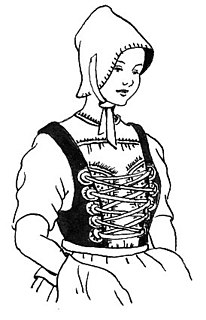 W
WA bodice is an article of clothing for women and girls, covering the torso from the neck to the waist. The term typically refers to a specific type of upper garment common in Europe during the 16th to the 18th century, or to the upper portion of a modern dress to distinguish it from the skirt and sleeves. The name bodice comes from an older garment called a pair of bodies.
 W
WThe boyar hat was a fur hat worn by Russian nobility between the 15th and 17th centuries, most notably by boyars, for whom it was a sign of their social status. The higher hat indicated the higher status.
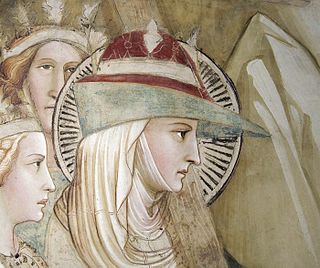 W
WA bycocket or bycoket is a style of hat that was fashionable for both men and women in Western Europe from the 13th to the 16th century. It has a wide brim that is turned up in the back and pointed in the front like a bird's beak. In French, it is called a chapeau à bec due to this resemblance.
 W
WA cap hook is a decorative hat ornament fashionable from the late Middle Ages through the Tudor period, used to pin up or decorate men's hat brims. Cap hooks were made of gold, silver, or silver-gilt base metal, and might be decorated with jewels or enamelling.
 W
WA capotain, capatain or copotain is a tall-crowned, narrow-brimmed, slightly conical "sugarloaf" hat, usually black, worn by men and women from the 1590s into the mid-seventeenth century in England and northwestern Europe. Earlier capotains had rounded crowns; later, the crown was flat at the top.
 W
WA chastity belt is a locking item of clothing designed to prevent sexual intercourse or masturbation. Such belts were historically designed for women, ostensibly for the purpose of chastity, to protect women from rape or to dissuade women and their potential sexual partners from sexual temptation. Modern versions of the chastity belt are predominantly, but not exclusively, used in the BDSM community, and chastity belts are now designed for male wearers in addition to female wearers.
 W
WA codpiece is a covering flap or pouch that attaches to the front of the crotch of men's trousers, enclosing the genital area. It may be held closed by string ties, buttons, folds, or other methods. It was an important fashion item of European clothing during the fifteenth and sixteenth centuries. In the modern era, clothing devices with similar functions as codpieces are worn in some styles of underwear, in the leather subculture, and in performance costumes, such as for rock music and metal musicians. A similar device with rigid construction, an athletic cup, is used as protective underwear for male athletes.
 W
WA corset is a support garment commonly worn to hold and train the torso into a desired shape, traditionally a smaller waist or larger bottom, for aesthetic or medical purposes, or support the breasts. Both men and women are known to wear corsets, though this item was for many years an integral part of women's wardrobes.
 W
WThe corset has been an indispensable supportive undergarment for women, in Europe for several centuries, evolving as fashion trends have changed and being known, depending on era and geography, as bodies, stays and corsets. The appearance of the garment represented a change from people wearing clothes to fit their bodies to changing the shape of their bodies to fit their fashionable clothing.
 W
WA doublet is a man's snug-fitting jacket that is shaped and fitted to the man's body which was worn in Spain and was spread to Western Europe from the late Middle Ages up to the mid-17th century. The doublet was hip length or waist length and worn over the shirt or drawers. Until the end of the 15th century, the doublet was usually worn under another layer of clothing such as a gown, mantle, overtunic or jerkin when in public.
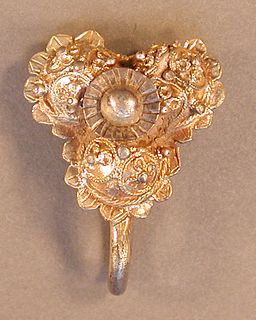 W
WA dress hook is a decorative clothing accessory of the medieval and Tudor periods used to fasten outer garments or to drape up skirts. Made of base metal or precious silver and silver-gilt, dress hooks are documented in wills and inventories, and surviving hooks have been identified in the archaeological record throughout England.
 W
WAndrew Edgar was a Scottish tailor who served James V of Scotland.
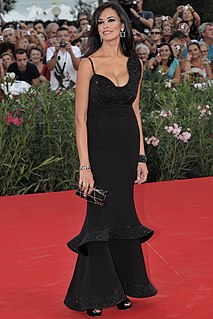 W
WAn evening gown, evening dress or gown is a long dress usually worn at formal occasions. The drop ranges from ballerina, tea, to full-length. Such gowns are typically worn with a evening gloves. Evening gowns are usually made of luxurious fabrics such as chiffon, velvet, satin, organza, etc. Silk is a popular fibre for many evening gowns. Although the terms are used interchangeably, ball gowns and evening gowns differ in that a ball gown will always have a full skirt and a fitted bodice, while an evening gown can be any silhouette—sheath, mermaid, A-line, or trumpet shaped—and may have straps, halters or even sleeves.
 W
WA farthingale is one of several structures used under Western European women's clothing in the 16th and 17th centuries to support the skirts in the desired shape and enlarge the lower half of the body. It originated in Spain in the fifteenth century. Farthingales served important social and cultural functions for women in Renaissance Europe as they were used, primarily by court women, to show their high social position and wealth. This is because these structures increased the amount of expensive fabrics used in the gowns that covered them.
 W
WThe French hood is a type of woman's headgear that was popular in Western Europe in the 16th century.
 W
WFrock has been used since Middle English as the name for an article of clothing, typically coat-like, for men and women.
 W
WA gable hood, English hood or gable headdress is an English woman's headdress of c. 1500–1550, so-called because its pointed shape resembles the gable of a house. The contemporary French hood was rounded in outline and unlike the gable hood, less conservative, displaying the front part of the hair.
 W
WA gamurra was an Italian style of women's dress popular in the fifteenth and early sixteenth centuries. It could also be called a camurra or camora in Florence or a zupa, zipa, or socha in northern Italy. It consisted of a fitted bodice and full skirt worn over a chemise. It was usually unlined.
 W
WA gown, from the Saxon word, gunna, is a usually loose outer garment from knee- to full-length worn by men and women in Europe from the Early Middle Ages to the 17th century, and continuing today in certain professions; later, gown was applied to any full-length woman's garment consisting of a bodice and attached skirt. A long, loosely fitted gown called a Banyan was worn by men in the 18th century as an informal coat.
 W
WThe hennin was a headdress in the shape of a cone, steeple, or truncated cone worn in the late Middle Ages by European women of the nobility. They were most common in Burgundy and France, but also elsewhere, especially at the English courts, and in Northern Europe, Hungary and Poland. They are little seen in Italy. It is unclear what styles the word hennin described at the time, though it is recorded as being used in French in 1428, probably before the conical style appeared. The word does not appear in English until the 19th century. The term is therefore used by some writers on costume for other female head-dresses of the period.
 W
WA hoop skirt or hoopskirt is a women's undergarment worn in various periods to hold the skirt extended into a fashionable shape.
 W
WHose are any of various styles of men's clothing for the legs and lower body, worn from the Middle Ages through the 17th century, when the style fell out of use in favour of breeches and stockings. The old plural form of "hose" was "hosen". In German these terms remained in use and are the generic terms for trousers today. The French equivalent was chausses.
 W
WA jerkin is a man's short close-fitting jacket, made usually of light-coloured leather, and often without sleeves, worn over the doublet in the sixteenth and seventeenth centuries. The term is also applied to a similar sleeveless garment worn by the British Army in the 20th century.
 W
WThe jewellery and jewels owned by James V of Scotland are mainly known from the royal treasurer's accounts and inventories. James V reinforced his authority by lavish display.
 W
WSeveral documents list the jewels of Margaret Tudor, daughter of Henry VII of England and Elizabeth of York. Margaret married James IV of Scotland in 1503.
 W
WAn inventory of the jewels of Mary I of England, as Princess Mary in the years 1542 to 1546 was kept by her lady in waiting Mary Finch. The manuscript is now held by the British Library. It was published by Frederic Madden in 1831. Some pieces are listed twice. Hans Holbein the Younger designed jewels for her. Two surviving drawings feature a ribbon with the inscription, "MI LADI PRINSIS".
 W
WThe jewels of Mary, Queen of Scots (1542–1587), are mainly known through the evidence of inventories held by the National Records of Scotland. She was bought jewels during her childhood in France, adding to those she inherited. She gave gifts of jewels to her friends and to reward diplomats. When she abdicated and went to England many of the jewels she left behind in Scotland were sold or pledged for loans, first by her enemies and later by her allies. Mary continued to buy new jewels, some from France, and use them to reward her supporters. In Scotland her remaining jewels were worn by her son James VI and his favourites.
 W
WThe kokoshnik is a traditional Russian headdress worn by women and girls to accompany the sarafan. The kokoshnik tradition has existed since the 10th century in the ancient Russian city Veliky Novgorod. It spread primarily in the northern regions of Russia and was very popular from 16th to 19th century. It is still to this day an important feature of Russian dance ensembles and folk culture and inspired the Kokoshnik style of architecture.
 W
WThe Monmouth cap was an item of woollen headgear fashionable between the 15th and 18th centuries, and associated with the town of Monmouth in South East Wales. The knitted round caps were used by both soldiers and sailors, and they were widely exported.
 W
WOver-the-knee boots, OTK boots, are long boots that fully or partly cover the knee. Originally created as a man's riding boot in the 15th century, in the latter part of the 20th century, the style was redefined as a fashion boot for women. Over-the-knee boots are also used as a work boot in circumstances requiring additional protection for the legs.
 W
WA partlet or partlett was a 16th century fashion accessory. The partlet was a sleeveless garment worn over the neck and shoulders, either worn over a dress or worn to fill in a low neckline.
 W
WA peascod belly is a type of exaggeratedly padded stomach that was very popular in men's dress in the late 16th and early 17th centuries. The term is thought to have come from "peacock," or from the form of contemporary plate armour. Sometimes it was called a 'goose belly.'
 W
WA petticoat or underskirt is an article of clothing, a type of undergarment worn under a skirt or a dress. Its precise meaning varies over centuries and between countries.
 W
WA rebozo is a long flat garment, very similar to a shawl, worn mostly by women in Mexico. It can be worn in various ways, usually folded or wrapped around the head and/or upper body to shade from the sun, provide warmth and as an accessory to an outfit. It is also used to carry babies and large bundles, especially among indigenous women. The origin of the garment is unclear, but most likely derived in the early colonial period, as traditional versions of the garment show indigenous, European and Asian influences. Traditional rebozos are handwoven from cotton, wool, silk and rayon in various lengths but all have some kind of pattern and have fringe, which can be finger weaved into complicated designs. The garment is considered to be part of Mexican identity and nearly all Mexican women own at least one. It has been prominently worn by women such as Frida Kahlo, actress María Félix and former Mexican first lady Margarita Zavala and still popular in rural areas of the country. However, its use has diminished in urban areas.
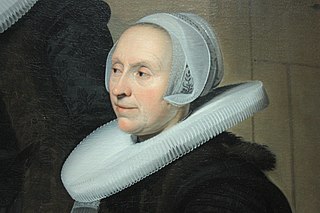 W
WA ruff is an item of clothing worn in Western, Central, and Northern Europe from the mid-16th century to the mid-17th century. The round and flat variation is often called a millstone collar after its resemblance to millstones for grinding grain.
 W
WIn sewing and dressmaking, a ruffle, frill, or furbelow is a strip of fabric, lace or ribbon tightly gathered or pleated on one edge and applied to a garment, bedding, or other textile as a form of trimming.
 W
WA sabot is a clog from France or surrounding countries such as The Netherlands, Belgium or Italy. Sabots are either whole-foot clogs or a heavy leather shoe with a wooden sole.
 W
WPeter Sanderson was an Edinburgh tailor who worked for Anne of Denmark wife of James VI of Scotland.
 W
WA sarafan is a long, trapezoidal Russian jumper dress worn by girls and women and forming part of Russian traditional folk costume.
 W
WRobert Spittell or Spittall or Spittale was a Scottish tailor who served Margaret Tudor, queen consort of James IV of Scotland.
 W
WA supportasse or underpropper is a stiffened support for a ruff or collar. Essential items of courtly fashion in the late 16th and early 17th centuries, supportasses are sometimes called piccadills, whisks, or rebatos, terms used at different times for both the supporters and the various lace or linen collar styles to which they were attached.I pray you, sir, what say you to these great ruffs, which are borne up with supporters and rebatoes, as it were with post and rail?
 W
WA visard is an oval mask of black velvet, worn by travelling women in the 16th century to protect their skin from sunburn. It was not held to the head by a fastening, but rather the wearer would clasp a bead attached to the interior of the mask between their teeth. The fashion of the period for wealthy women was to keep their skin pale, because a tan suggested that the bearer worked outside and was hence poor.
 W
WA vlieger is a type of sleeveless over-gown or cape worn by women in the late 16th and early 17th-centuries. Variations with short sleeves or high shoulder rolls are known. Sometimes sleeves were attached with aiglets, and often slits were made to allow belts or the hands to pass through.
 W
WThe wardrobe of Mary, Queen of Scots, was described in several contemporary documents, and many records of her costume have been published.